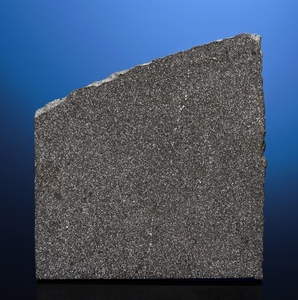Deep Impact: Martian, Lunar and other Rare Meteorites
One edge of the meteorite’s external surface arcs across the top of this specimen. The polished face of this partial slice evidences a cool ebony matrix with thousands of tiny grains of iron-nickel seemingly dusted across the meteorite’s surface. A strand of metal laces through the midsection of the face of the specimen. Modern cutting.
141 x 129 x 3 mm. (5½ x 5 x ⅛ in.) and 274.7 g. (⅔ lbs)
Found in 1883 and containing a galaxy of metal-flake inclusions, the main mass of the Estacado meteorite was acquired by New York City’s American Museum of Natural History from which this specimen was deaccessioned. Estacado is an H6 chondrite which infers it would have an abundance of chondrules if it had not been heated sufficiently to recrystallize its chondrules and homogenize its mineral compositions. The arc of metal traversing the surface attests to an energetic impact that melted some of the small iron-nickel grains and blasted the metal melt into a fracture in the sample. The end result is a sublime meteorite that attests to the myriad processes that occurred on asteroids orbiting the Sun between Mars and Jupiter.
Christie's would like to thank Dr. Alan E. Rubin at the Institute of Geophysics and Planetary Physics, University of California, Los Angeles for his assistance in preparing this catalog note.
View it on
Estimate
Time
Auction House
One edge of the meteorite’s external surface arcs across the top of this specimen. The polished face of this partial slice evidences a cool ebony matrix with thousands of tiny grains of iron-nickel seemingly dusted across the meteorite’s surface. A strand of metal laces through the midsection of the face of the specimen. Modern cutting.
141 x 129 x 3 mm. (5½ x 5 x ⅛ in.) and 274.7 g. (⅔ lbs)
Found in 1883 and containing a galaxy of metal-flake inclusions, the main mass of the Estacado meteorite was acquired by New York City’s American Museum of Natural History from which this specimen was deaccessioned. Estacado is an H6 chondrite which infers it would have an abundance of chondrules if it had not been heated sufficiently to recrystallize its chondrules and homogenize its mineral compositions. The arc of metal traversing the surface attests to an energetic impact that melted some of the small iron-nickel grains and blasted the metal melt into a fracture in the sample. The end result is a sublime meteorite that attests to the myriad processes that occurred on asteroids orbiting the Sun between Mars and Jupiter.
Christie's would like to thank Dr. Alan E. Rubin at the Institute of Geophysics and Planetary Physics, University of California, Los Angeles for his assistance in preparing this catalog note.



